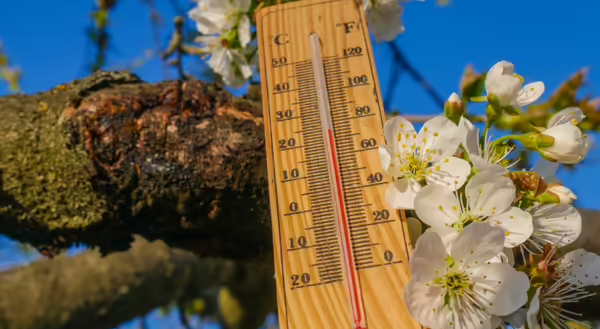
This past week, right around mid-June, I received my first question about Japanese beetles. Throughout a growing season, plants, insects, diseases, and many other natural processes emerge, develop, and complete their life cycles. How do we know when to expect Japanese beetles to emerge? Or squash vine borers? To help answer these questions, we can use weather data.
When the weather warms up quickly, insects tend to emerge sooner and plants bloom earlier. The opposite can also be true during a growing season with cooler weather. At a basic level, heat equals energy and is a primary driver of life cycles on our planet.
In Illinois, we track this heat accumulation using a system called Growing Degree Days (GDD). GDD helps us predict when certain insects will emerge, when plants will bloom, and when diseases might appear.
What Are Growing Degree Days (GDD)?
To measure GDD, we must know an organism's base temperature to know when to start tracking heat units. The base temperature is a threshold of growth, where no development takes place below that level. Let’s use insects as an example: The optimum range above the base temperature is when the insect will hatch, grow, eat, mate, and lay eggs. Being cold-blooded creatures, temperature plays a major role in the growth and development of an insect, and the temperature often used is 50 degrees Fahrenheit, or base 50 temperature. Not all GDD uses base 50 temperature. Some organisms begin their lifecycle as soon as we rise above freezing, so that would be a base 32 temperature. Each organism's base temperature is determined through lab and field research. Typically, organisms with a base 32 temperature start tracking on January 1, and base 50 starts on March 1.
How to Calculate GDD
By calculating GDD, we can predict the activity of insects, disease, and weeds. There are multiple ways to calculate GDD. Perhaps the simplest way is the Average Method. This can be done by adding together the high and low temperatures for the day and dividing that value by two to get the average. If the average temperature is at or below the base temperature for a crop or pest of interest, then the GDD value is zero. If the average temperature is above the base temperature, then the GDD equals the difference between the average temperature minus the base temperature. So, if you have an average temperature of 51 degrees for that day and use a base temperature of 50 degrees, you have accumulated one degree day. Add the GDD each day to keep a running total during the growing season.
Calculate GDD with this formula:
((Max Temp + Min Temp) ÷ 2) - 50 = GDD Accumulation for the Day
Fortunately, you don't have to calculate the daily GDD accumulation. During the growing season, several educational, agricultural, and landscaping organizations, such as the Morton Arboretum, publish GDD data. However, most of these are using the GDD Tracker from Michigan State University, found online at gddtracker.msu.edu.
Why GDD Matters for Gardeners and Landscapers
But what does this all mean for gardeners and landscapers? It allows us to have a heads up on when we might expect to see certain insects emerge in the landscape, or at least not be surprised if they show up earlier than in the past. Let’s use Quincy, Illinois as an example: on June 24, 2025, Quincy has 1,320 GDD. One year ago on this day, Quincy had 1,540 GDD. This means that insects are emerging later this year compared to 2024.
Japanese beetle adults begin to emerge and feed at 950 accumulated degree days, which means that they should already be out feeding as we are well beyond their base minimum for becoming active. Other insects, such as Squash Vine Borer adults, emerge around 900 GDD and begin laying eggs at 1000 GDD.
By following GDD, you can use it as a more effective guide for scouting and applying chemical controls for insect pests in the landscape as compared with a general "these insect pests usually arrive in late June/early July." Use GDD as part of an integrated pest management plan – one where you find a balance between chemical, cultural, and mechanical methods of control and plant care.
Good Growing Fact of the Week: The higher your average daily temperature over the base 50 temperature, the more GDD you accumulate. For the past three years, Quincy’s total season average has been slightly over 3,500 GDD.
Growing Degree Day (GDD) Resources
Illinois Climate Network: Daily Pest Degree Day calculator for commodity and specialty crops
Sign up for our emails! Want to get notified when new Good Growing posts are available? SIGN ME UP
Give us feedback! How helpful was this information (click one): Very helpful | Somewhat helpful | Not very helpful
MEET THE AUTHOR
Chris Enroth is a horticulture educator with University of Illinois Extension, serving Henderson, McDonough, Knox, and Warren counties since 2012. Chris provides horticulture programming with an emphasis on the home gardener, landscape maintenance personnel, and commercial landscapers. Additional responsibilities include coordinating local county Master Gardener and Master Naturalist volunteers - providing their training, continuing education, advanced training, seasonal events, and organizing community outreach programs for horticulture and conservation assistance/education. In his spare time, Chris enjoys the outdoors, lounging in the garden among the flowers (weeds to most).